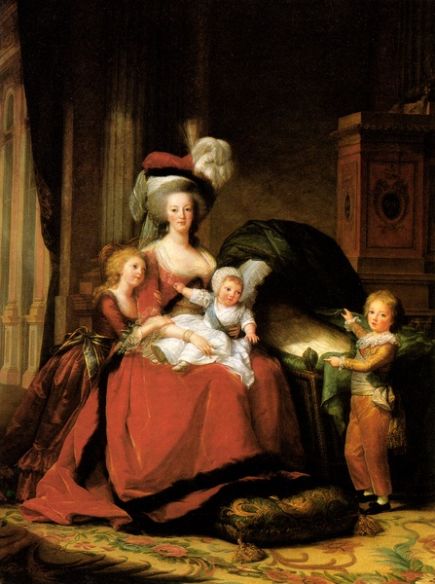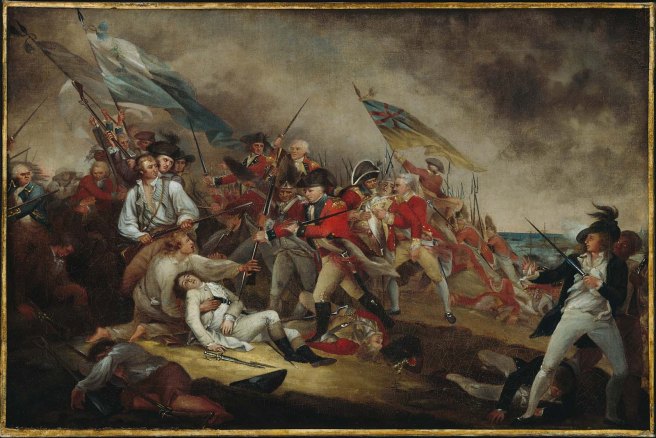Societal goings-on influence the subject matter and style of art, and this is (often violently) obvious in the art of the late 1700s when the topic of revolution took over many paintings. France and America were going through major changes that were immortalized by the artists of the day. Revolution is a serious topic, and this is reflected by the shift from the fanciful Rococo style to the Classical style. The straight lines and austerity of art stood in direct opposition to the ornateness and light colors of the aristocracy. The art of this period was meant to provoke patriotism and promote the revolutionary cause.

One of the reasons for revolution in France was the excess of the aristocracy and royals. This can be seen in paintings such as this one, Marie Antoinette and her Children by Élisabeth Lousie Vigée Le Brun, set in the opulent palace of Versailles during 1787. Here we still have a Rococo painting, that is softly lit, with doll-like people. The queen is dressed in a fur lined, rich dress, which did not help her image with people in France who were poor and hungry. The whole purpose for this painting was to combat the unpopularity of the monarchs that would eventually lead to revolution. The queen is posed with her children in an attempt to make her seem likable and benevolent. This did not help, as this was the last ever portrait of her before she was guillotined. Revolution signaled an end to the Rococo style in France which was associated with frivolous paintings and ushered in the Classical style.

Here we have The Death of Merat painted in 1793 by the French artist Jacques-Louis David. Merat was a leader of the French Revolution who was killed by rivals. Here we see him made into a martyr for the cause of freedom. He is surrounded by white cloth, symbolizing his purity. He is a portrayed as a hardworking man, holding his quill even though he is in the bath. This also indicates his vulnerability and unfair death, he had no time to fight back. The austerity of the painting emphasizes his figure, and the lights reflects on him dramatically. His face is realistic, not doll-like, which only brings the viewer more sadness and makes the scene more realistic and emotional.

Of course, France was not the only place to have a revolution. America was first and this inspired painting such as the descriptively titled The Death of General Warren at the Battle of Bunker’s Hill, 17 June, 1775 completed by John Trumbull in 1786. Warren was a patriot who was killed on Bunker Hill. Here the revolutionaries are depicted sympathetically, while the British are aggressively rushing them, stepping on the bodies of their dead comrades. The body of Warren is lit by a soft light, turning him into another martyr for the cause of revolution. Portraits such as this made the revolutionaries heroic and immortalized their legacy for generations to come.
“Jacques-Louis David: The Death of Marat.” Boston College. Accessed 4 Oct. 2016. http://www.bc.edu/bc_org/avp/cas/his/CoreArt/art/neocl_dav_marat.html
Stauble, Katherine. "Marie Antoinette and her Children: An Icon of French Painting." National
Gallery of Canada Magazine, 19 Apr. 2016. Accessed 4 Oct. 2016.http://www.ngcmagazine.ca/features/marie-antoinette-and-her-children-an-icon-of-french-painting
"The Death of General Warren at the Battle of Bunker's Hill, 17 June, 1775." Museum of Fine Arts
Boston. Accessed 4 Oct. 2016. http://www.mfa.org/collections/object/the-death-of-general-warren-at-the-battle-of-bunkers-hill-17-june-1775-34260
I really like how serious you looked at this topic. I feel you were interested or felt very strong about one side of the whole thing. The art used honestly wasn’t that pleasing to my eyes, for example I wouldn’t want to hang these paintings in my home. They are just too dark for me. The Death of General Warren at the Battle of Bunker’s Hill was a perfect example of what you are presenting here, I really liked that example.There tends to be a lot of blood in these paintings, except for the first one, why is that? What is blood a symbol of?
LikeLike
You did a great job expressing the art! You provided an array of background details that allowed me to see your view on the paintings, and how it all ties together, which is another thing I felt you did that helped me see the overall blog better; you kept a theme for the paintings. The first one differs a little as it is not a bloody scene, but she is meant to look likable and benevolent, she is meant to be a leader, which ties into your last painting, as the soldiers are advancing, and the opponent begging, looking “cowardly” compared to the advancing army. The middle painting you chose, The Death of Merat, ties in with both, as the man, David, as he was killed by the revolution, yet the painting still portrays a softness, much like the first to make him a likable man.
LikeLike
I have to agree with the first comment, these paintings have value but for me it’s not decorative value — I wouldn’t have any of these in my home, and I would probably skip this section of a museum if I wasn’t there for history specifically. It isn’t the subject matter for me though, it’s the lightness and strange appearance of the bodies and faces that I find unnerving. This style has always looked kind of cartoonish and garish to me. I appreciate that you highlighted the serious theme behind these paintings, because for some reason all three of them kind of make me want to laugh, even though there’s nothing funny about them. These were great choices to represent your theme and the accompanying explanations follow a logical progression and are very informative.
LikeLike